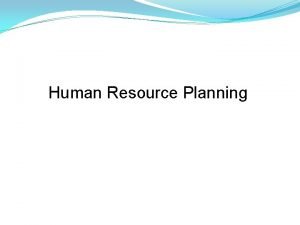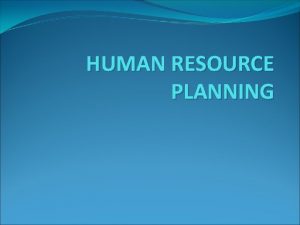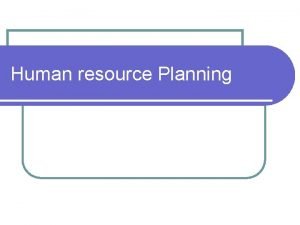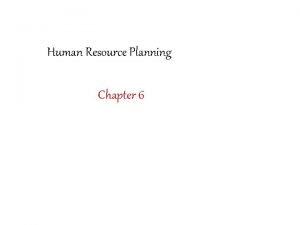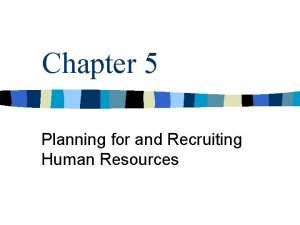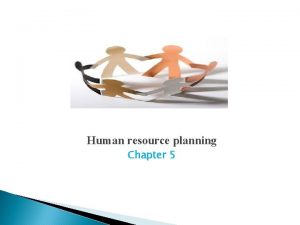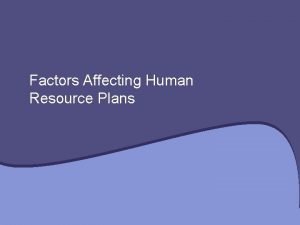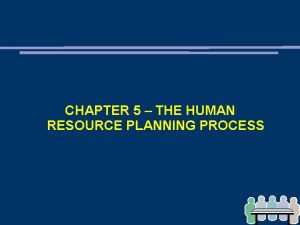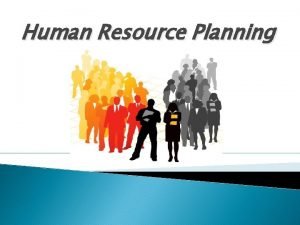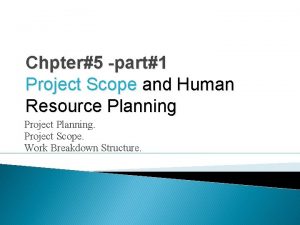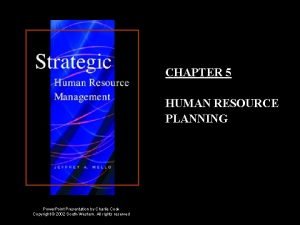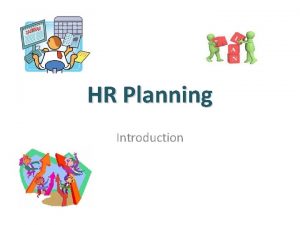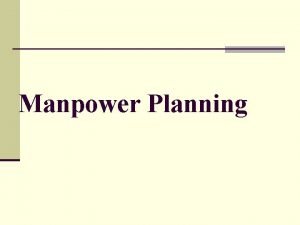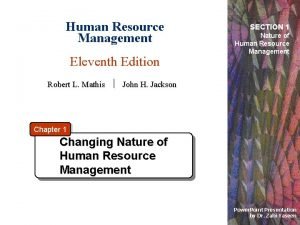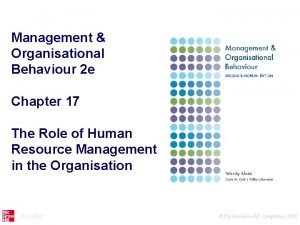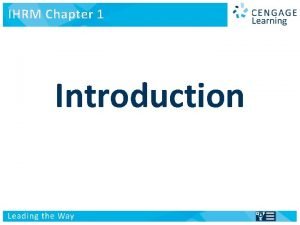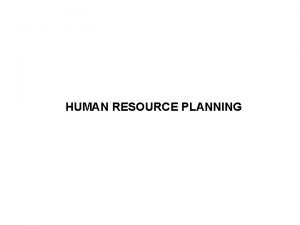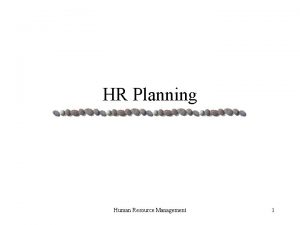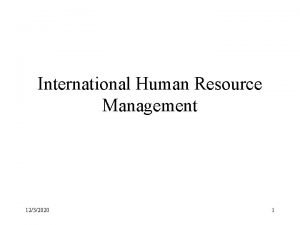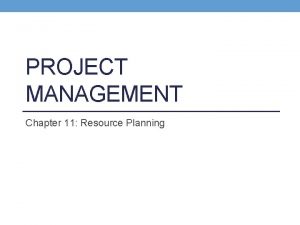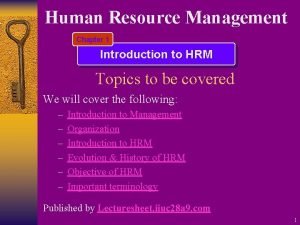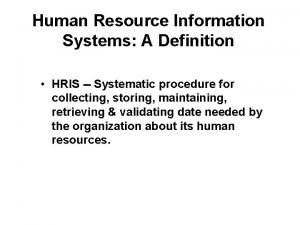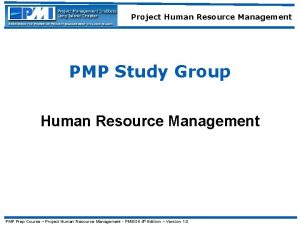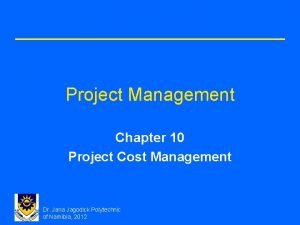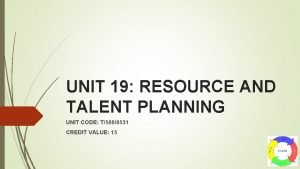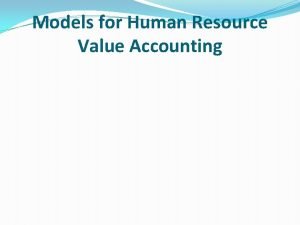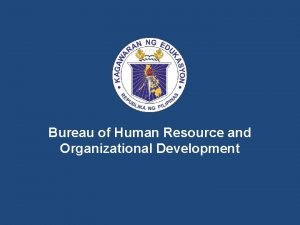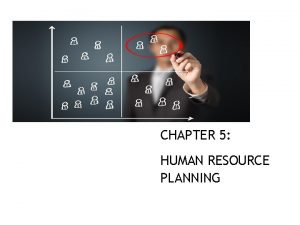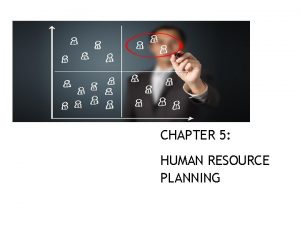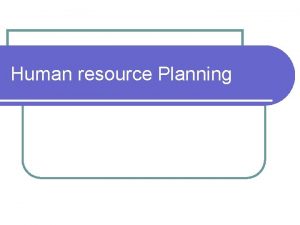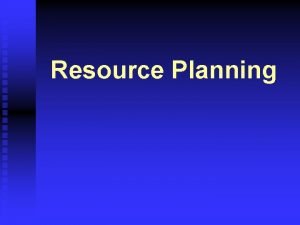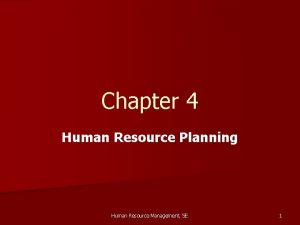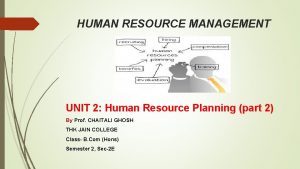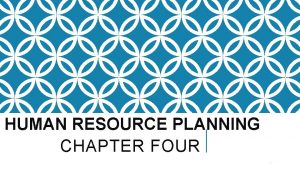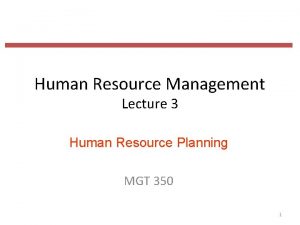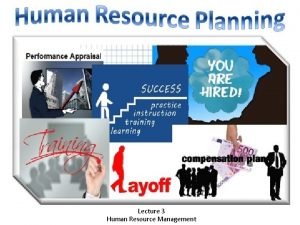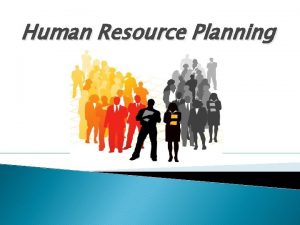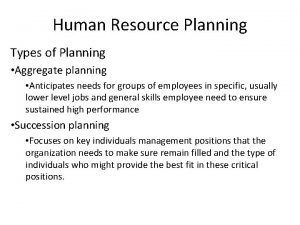HUMAN RESOURCE PLANNING MEANING AND DEFINITION In simple










































- Slides: 42

HUMAN RESOURCE PLANNING

MEANING AND DEFINITION In simple words, HRP is understood as the process of forecasting an organization's future demand for, and supply of, the right type of people in the right number. After this only the HRM department can initiate the recruitment and selection process Its called by manpower planning, personal planning or employment planning

DEFINITION OF HRP • It includes the estimation of how many qualified people are necessary to carry out the assigned activities, how many people will be available, and • Basically it’s the process by which an organization ensures that it has the right number & kind of people, at the right place, at the right time, capable of effectively & efficiently completeing those tasks that will help the organisation achieve its overall objectives.

Definition According to Beach: - “Human Resource Planning is the process of determining & assuming that the organization will have an adequate number of qualified persons available at the proper lines, performing jobs which meet the needs of the enterprise & which provide satisfaction for the individuals involved. According to Stainer: - “Human Resource Planning is the strategy for the acquisition movement & preservation of an organiation’s Human Resource.

Objectives of Human Resource Planning To ensure optimum use of Human Resources currently employed; To assess or forecast future skill requirements of the organisation‘s overall objectives; To provide control measure to ensure availability of necessary resources when required; To control the cost aspect of Human Resources; To formulate transfer and promotion policies.

IMPORTANCE OF HRP FUTURE PERSONNEL NEEDS 1. • Surplus or deficiency in staff strength 2. COPING WITH CHANGE • Enables an enterprise to cope with changes in competitive forces, markets, technology, products & government regulations 3. CREATING HIGHLY TALENTED PERSONNEL • HR manager must use his/her ingenuity to attract & retain qualified & skilled personnel • Succession planning. 4. INTERNATIONAL STRATEGIES • Fill key jobs with foreign nationals and re-assignment of employees from within or across national borders

IMPORTANCE OF HRP 5. FOUNDATION FOR PERSONNEL FUNCTIONS • Provides information for designing & implementing recruiting, selection, personnel movement(transfers, promotions, layoffs) & training & development 6. Protection of weaker section of society 7. Resistance to change

FACTORS AFFECTING HRP I. ORGANIZATIONAL GROWTH CYCLES & PLANNING • • Embryonic stage – No personnel planning Growth stage – HR forecasting is essential Maturity stage – Planning more formalized & less flexible Declining stage – Planning for layoff, retrenchment & retirement II. ENVIRONMENTAL UNCERTAINITIES • Political, social & economic changes

FACTORS AFFECTING HRP III. TIME HORIZONS • Short-term & Long-term plans IV. TYPE & QUALITY OF FORECASTING INFORMATION • Type of information which should be used in making forecasts

ENVIRONMENT ORGANISATIONAL OBJECTIVES AND POLICIES HR NEEDS FORECAST HR SUPPLY FORECAST HR PROGRAMMING HRP IMPLEMENTATATION CONTROL AND EVALUATION OF PROGRAMME SURPLUS RESTRICTED HIRING REDUCED HOURS VRS, LAY OFF, etc SHORTAGE RECRUITMENT AND SELECTION THE HRP PROCESS

Organizational Objectives and Policies HR plans need to be based on Organizational Objectives. The role of HRP is to subserve the overall objectives by ensuring availability and utilization of Human Resources. In developing these objectives, specific policies need to be formulated to address the following questions: Are vacancies to be filled from promotions from within or hiring from outside? How do training and development objectives interfere with the HRP objectives? What union constraints are encountered in HRP and what policies are needed to handle these constraints? How to enrich employees job? Should the routine and boring jobs continue or be eliminated? How to downsize the organization to make it more competitive?

HR Demand Forecast Demand forecasting is the process of estimating the future quantity and quality of people required. The basis of the forecast must be the annual budget and longterm corporate plan, translated into activity levels for each function and department

HR SUPPLY FORECAST Supply forecasting measures the no of people likely to be available from within and outside an organisation, after making allowance for absenteeism, internal movements and promotions, wastage and changes in hours and other conditions of work.

HR programming After personal demand supply are forecast the vacancies should be filled at right time with right employees.

HR Plan implementation Converting HR plan into action. Action programmes are. . Recruitment Selection & placement Training and development Retraining & redeployment The retention plan The redundance plan The succession plan

Control and evaluation Establish the reporting procedures Identifying who are in post and those who are in pipe line It should report employment costs against budget and trends in wastage and employment ratios

to determine and to identify present and prospective needs of Human Resource, to discover and recruit the required number of persons. to select the right number and type from the available people. to hire and place in the positions for which they are qualified, to provide information to the selected people about the nature of work assigned to them, to Promote or to transfer as per the needs and the performance of employees, to denote if the employees are disinterested or their performance is not up to the mark, to terminate if they are not needed or their performance is below standard and shows no hopes of improvement.

Problems of Human Resource Planning Improper linkage between HRP and corporate strategy Inadequate appreciation of human resource management Rigidity of attitudes Conflict between short term and long term plan inappropriate human resource information system

Forecasting Human Resource Demand analysis identifies the future human resource requirements needed to maintain the organization’s mission and goals. The end result of a demand analysis is the identification of the required number of employees in an organization and the necessary functions that the employee must perform to meet organizational objectives.

Quantitative Techniques for Forecasting Human Resource Demand Trend Analysis past trends and ratios can also be used to forecast Human Resource demand. Trend analysis predicts the demand for labour based on projections of past relationship patterns over a number of years. As one of the simpler methods of forecasting Human Resource demand, trend analysis assumes that an organization’s past employment needs are indicative of future needs when linked with an operational index.

Ratio Analysis Ratio analysis estimates future Human Resource demand based on ratios between assumed casual factors and the number of employees needed. § Regression Analysis § Projects the future demand based on the past relationship with the work force level and the basic factor on whom the demand is assumed to depend.

Qualitative Techniques for Forecasting Human Resource Demand Delphi Method Delphi method process involves a panel of experts using their judgments to make estimates of short-term future demands. Experts use a variety of factors to make their judgements, including economical, demographical, technological, legal, and social conditions outside of the organization, During the process, experts are not permitted to engage in direct faceto-face contact or communication. First, experts must be identified to participate in this task. Second, each expert is asked to submit Human Resource demand forecasts, including specification of sources of information and assumptions used to estimate demand. Next stage , each submission is gathered by Human Resource Planning and Development Page 11 Human Resource planning group, which then summarizes the results. T he aggregated results are sent back to the experts, who are given an opportunity to adjust their forecasts based on the information provided in the summaries. These steps are repeated until the expert opinions converge.

Nominal Group Technique This process involves multiple experts (usually line and department managers) meeting face to discuss independently formulated positions of an organizational issue, with the ultimate aim of securing an accurate assessment of a given situation. It can be used to help forecast Human Resource demand for an organization or can be used to solve other organizational issues.

Scenario Analysis Scenario analysis provides multiple estimates of future Human Resource demand, contingent on a unique set of assumptions and circumstances for each scenario. This method involves recognizing uncertainties about the future. An organization can create Human resource estimates accordingly, one for a constant economic situation (e. g. , zero growth), a second for some anticipated economic growth (e. g. , five percent growth), and a third for the possibility of economic decline (e. g. , five percent reduction).

Forecasting Human Resource Supply The objective of identifying future Human Resource supply requirements is to determine the number of employees in each job and their knowledge, skills, abilities, and other characteristics. In addition, forecasting Human Resource supply is essential in determining the characteristics of hiring sources within the predetermined planning horizon in order to establish whether future Human Resource supply is sufficient to match future Human Resource demands.

Forecasting External Human Resource Supply Information that will help to develop an understanding of external Human Resource supply includes: Supply and demand of jobs or skills Educational attainment levels within a region Compensation patterns based on experience, education, or occupation Immigration and emigration patterns within an area Forecasts of economic growth or decline Competition for talent Industry or occupational expected growth levels.

Wastage analysis Manpower wastage is an element of labour turnover. It includes voluntary retirement, normal retirement resignations, deaths and dismissals. Marginal recruitment decisions without wastage analysis may lead to inaccuracies in HRP. Different Methods Labour Turnover Index Stability Index Skills Inventories

Labour Turnover Index Indicates number of leavers as percentage to average number of employees. Average number of employees employed in a given time period is decided by adding the employees at the beginning and end and then dividing the same by two. Labour Turnover Index Labour Turnover= Number of employees leaving/ Average no. of employees employed. Stability Index Indicates stable work force percentage for a given period Stability Index =No. with more than 1 year service now * 100 Total employed one year ago

Replacement Charts A replacement chart is used to estimate vacancies in higher level jobs and identify how potential Human Resource supply can fill these vacancies via internal movements from lower levels jobs. A comprehensive replacement chart will include information regarding possible replacements for vertical or horizontal movement. Generally, a replacement chart includes information about employees’ performance, readiness to fill the position, and education. Staffing Tables A staffing table provides a clear graphical view of all organizational jobs and the current number of employees at each job. It presents a simple visual understanding of an organization’s staffing level within each department and the organization as a whole, in an effort to help understand the combination of employees that make up an organization’s internal workforce.

Stock Taking taking counts human resources in quantitative / qualitative terms, in an organization. Also called human resource inventorry.

Skill Inventory A skills inventory is a system designed to take stock of information about current employees’ experience, education, compensation history, and/or unique abilities. A skills inventory can be useful in revealing what skills are immediately available in an organization by providing a snapshot view of the existing talent in an organization. Identifying current workforce dynamics is a critical step in the development of a Human Resource

• Skill inventories 1. Personal data 2. Skills 3. Special qualifications 4. Salary and job history 5. Company data 6. Capacity of individual 7. Special preference of individual

• Management inventories 1. Work history 2. Strengths 3. Weakness 4. Promotion potential 5. Career goals 6. Personal data 7. Number and types of employees supervised 8. Total budget managed 9. Previous management duties.

workforce flow mapping A human resources diagnostic tool involving analyzing the stages and dynamics of labor performed by employees that is generally used to make a company’s staff more productive. The workforce flow map would ideally begin by choosing an area to improve. A team is then assembled and problems are identified. The team brainstorms solutions and steps are then taken to develop and implement a plan.

Markov analysis Analysis that helps to predict internal employee movement from one year to another by identifying percentages of employees who remain in their jobs, get promoted or demoted, transfer, and exit out of the organization

Succession Planning Succession planning is a longer-term process of grooming a successor (selected from a pool of candidates on the basis of perceived competency) for management or critical positions.

Managerial succession planning Analysis of demand Audit of existing executives Planning of individual career path Career counseling Accelerated promotions Performance related training and development Planned strategic recruitment Filling the openings

Employee Retention You go to considerable trouble and expense to identify, interview, and hire great employees for your organization. So retaining them should also be a top priority. Luckily, most good retention practices are inexpensive to implement. Key strategies Recruitment and hiring. Orientation and on boarding. Training and development. Performance evaluation. . Pay and benefits. Internal communication. Engage employees to increase retention

Redundancy Termination of employees for business reasons, such as poor economic conditions. Redundancies can be forced or voluntary in the case of voluntary redundancies there are usually incentives offered to outgoing employees, such as extended garden leave or more valuable severance packages Redundancies can be controversial, particularly if businesses must select who is to be made redundant. A commonly-used technique is Last In, First Out (LIFO), whereby the employees who have joined most recently are considered first for redundancy.

MACRO-level HRP focuses on aligning human resources administration with the organization's mission and overall strategic plan. Examines employee-management policies and procedures and their effect on human resources management.

Labor market analysis is the process of Identifying the appropriate labor market for various types of positions. Surveying the market to determine the salaries that are being paid for like positions. Identifying market trends such as: ancillary pay, and merit and pay practices.

Labor market analysis is a five part process to: Identify the area within which employers are competing for labor. Conduct or participate in market surveys within the labor market to determine the salaries being paid for specific positions. Identify market trends such as: ancillary pay, merit and pay practices. Establish, adjust, and/or recommend salary structures that will allow the company to effectively compete for staff within specific classification levels or grades.
 Hr planning meaning
Hr planning meaning Hrp meaning and definition
Hrp meaning and definition Resource forecasting meaning
Resource forecasting meaning What is human resource planning definition
What is human resource planning definition Hr planning meaning
Hr planning meaning Example of short term human resources
Example of short term human resources Induction in hrm
Induction in hrm Chapter 5 human resource planning and recruitment
Chapter 5 human resource planning and recruitment Significance of human resource planning
Significance of human resource planning 5 stages of human resource planning
5 stages of human resource planning Hr management final exam
Hr management final exam Factors affecting human resource planning
Factors affecting human resource planning Forecasting techniques in human resource planning
Forecasting techniques in human resource planning Swot analysis of hr manager
Swot analysis of hr manager Wbs human resource management
Wbs human resource management Human resource planning powerpoint presentation
Human resource planning powerpoint presentation Hr definition
Hr definition E.w. vetter human resource planning
E.w. vetter human resource planning Nature of personnel management
Nature of personnel management Markov analysis in hr
Markov analysis in hr Human resource planning steps
Human resource planning steps Difference between hrm and ihrm
Difference between hrm and ihrm Human
Human Wastage analysis in hrp
Wastage analysis in hrp Stability index in hrm
Stability index in hrm Meaning of human resource management
Meaning of human resource management Resource loading meaning
Resource loading meaning Resource planning definition in project management
Resource planning definition in project management Concept of hrm
Concept of hrm Introduction to human resource management
Introduction to human resource management Define hris system
Define hris system Human resource management plan pmp
Human resource management plan pmp Resource leveling is the approach to even out the peaks of
Resource leveling is the approach to even out the peaks of Perbedaan antara resource loading dan resource levelling
Perbedaan antara resource loading dan resource levelling Resource aggregation in project management
Resource aggregation in project management Resource and talent planning
Resource and talent planning Flamholtz model formula
Flamholtz model formula Strategic human resource
Strategic human resource Forms of retail organization
Forms of retail organization Bhrod deped
Bhrod deped Human resources and job design
Human resources and job design Define human resource management and payroll cycle
Define human resource management and payroll cycle Recruitment and selection in human resource management
Recruitment and selection in human resource management
